
Recently on Cyclingnews.com |
On test: Shimano Dura-Ace 7900 group, March 11, 2009
Give and take
 |
Shimano touts its latest Dura-Ace 7900 group to be the culmination of everything it’s learned over the past 35 years but is it really the best Dura-Ace yet? Cyclingnews technical editor James Huang spends five months on this new flagship and finds it to be a definite improvement in some areas – but disappointing in others.
Shimano’s head-to-toe overhaul of its premier Dura-Ace road group has yielded a dramatically new appearance, some long awaited features, lighter weight and a far heftier price tag. We got an initial taste last summer at the official launch in Japan and now that we’ve managed some real time on it we’re ready to draw some conclusions.
Ergonomics – flatter and longer
Shimano moved the shifter internals back into the base of the lever to allow for 7900’s now concealed derailleur housing and the new layout dictated a far different shape than before in order to make room.
The new lever now feels more substantial with a significant increase in girth (roughly 165mm vs. 140mm at the base) while the flatter and longer top distributes pressure more evenly for better long-term comfort. The slightly canted and broader carbon fiber lever blades are slightly easier to reach from the hoods, too, and a reach adjust mechanism is hidden within.
The concealed cables may yield a cleaner look but some riders will undoubtedly miss the extra hand position that 7800’s bulbous forward knob provided – left in its place is a far smaller nub that just doesn’t leave as much to hold on to and there are now no cables on which to hook your thumbs, either. 7800 converts accustomed to resting the base of their palms where the hood surface sweeps up to that knob might also find a stem swap is in order – on 7900, that spot is moved further out by nearly 10mm.
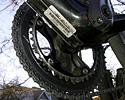 |
The shape changes will undoubtedly be polarizing but a few details simply left us scratching our heads.
While derailleur housings can be routed to either the front or back of the bar, the former configuration leaves an annoyingly sharp bump right at the base of your palm and it didn’t take long before it started to wear into the hood. Moreover, the wider base (35mm vs. 30mm for 7800) doesn’t taper much as it meets the bar and is noticeably harder to wrap well with bar tape.
In addition, the adjustable reach feature is nice to have but doing so leaves an uncharacteristically unsightly gap that smacks of afterthought.
Moreover, the reach adjust screw – and the brake cable – are concealed by a small cover plate reminiscent of Dura-Ace 7700. At least in this second go-around one needn’t remove the tiny retaining screw completely to pull off the plate though we doubt most people will pick up on that fact so they’ll lose the little guys anyway. Come on now, really?
Shifting performance – good overall but could be better
 |
We had grand expectations for 7900 after countless hours on Shimano’s latest XTR triggers what with their faster Instant Release cable spool and slick Multi-Release feature for multiple upshifts. Enter Dura-Ace 7900 and we got… none of the above.
Instead, 7900 now can only downshift two gears per sweep instead of three and though Shimano claims a 20 percent reduction in shift lever throw, our tape measures and protractors suggested otherwise. Upshifts still require a lengthy 20-degree arc (or 40mm of linear throw, 30mm of which is nothing but slop) and single downshifts an even longer 27 degrees or so.
In contrast, Dura-Ace 7800 requires a 20-degree throw for both upshifts and single downshifts so if anything, downshift throw on 7900 has actually gotten longer. Perhaps Shimano was measuring 7900’s throws from a vertical line? Either way, tsk tsk.
Despite the concealed housing’s additional bend, cable friction is only ever so slightly increased over 7800’s more direct route. Add in Shimano’s typical Light Action feel and you get a slightly more vague and disconnected feel than before but rear shift performance is still on par with 7800 overall if not quite as crisp. Chain movement across the cassette though is impeccably smooth – aided in part by the new asymmetrical chain – and full-power shifts are as reliable as ever in spite of the curiously flexy carbon rear derailleur cage.
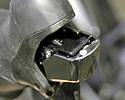 |
However, front shifts are flat-out amazing and without doubt the best in the industry by a substantial margin. Revised cable pull ratios yield a lighter lever feel and the ultra-stiff hollow outer chainring and revised front derailleur yield shift performance as reliable and smooth under power as on the rear – it’s no wonder sponsored riders quickly embraced the new chainring even on older Dura-Ace or SRM cranksets.
Interestingly, Shimano has done the same thing that many criticized SRAM for including on its first-generation Force group – eliminated the trim position for the outer chainring – yet we find it unlikely anyone will complain this time around. Though we were always able to get first-gen Force to work as intended, front derailleur setup is more straightforward on 7900 and there is simply no cage rub with any rear cog when in the big ring. Bravo.
Cable friction remains more of an issue for rear shifting over the long haul than with Campagnolo or SRAM though and the shifter internals are worrisomely exposed. ‘Cross riders in particular will take issue with the big gaps in the bottom of the hood through which the ratchet teeth are clearly visible. Even on the road, spray from leading riders invariably ended up inside the shifter and tended to gum up the works a bit.
Replacing derailleur cables is just as easy as before – though the insertion point is now further back in the body and hidden away beneath the hood – but now the derailleur housing isn’t nearly as easy to swap as on 7800 and typically there is little good in doing one without the other.
Braking performance – best yet from Shimano
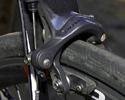 |
7900’s braking performance is definitely superior to 7800 with a snappier and more fluid lever feel plus noticeable improvements in power and modulation. Many readers have lamented the revised cable pull ratio on 7900 – thus sullying the idea of mixing groups – but if that is what was required to get this level of performance, so be it.
The pad contact point is very positive, the power comes on in a highly linear and predictable fashion, and the system is exceptionally flex-free courtesy of the well-reinforced calipers. Adding to the firm feel are the relatively hard pads, which don’t seem to have quite as much initial bite as some others when you’re just ambling along but then again also don’t squish much under compression, either.
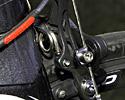 |
These new stoppers perform at their best when run fast and hard. We quickly found ourselves braking later and harder in corners, yet exiting with more momentum.
Pads have worn admirably well even with lots of high-speed mountainous descents, too.
Also worth mentioning are the slick low-profile barrel adjusters. They’re bigger and easier to use while on the road and produce smoother housing runs, especially out back on compact frames or on any bike with less than ideal routing.
Drivetrain – whisper quiet, impeccably smooth
 |
Though the crankarms are dramatically different from a finish standpoint from 7800, their overall construction and attachment method are very similar so there is little difference in arm stiffness. That’s hardly a bad thing considering 7800’s benchmark status and the fact that 7900 continues to be competitive weight-wise with carbon – and in some cases, even better – is testament to Shimano’s superior forging capabilities.
The cassette also hasn’t changed much, gaining an extra titanium cog in certain configurations and losing a few grams courtesy of some more aggressive machining and stamping.
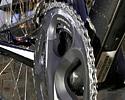 |
The new asymmetric chain is superb, though, running whisper-quiet – highlighting the relative clamor of SRAM Red – and offering real-world improvements in shift smoothness both up and down and at either end over last year’s 10-speed chain. A convenient master link (not tested here, unfortunately) makes for easier removal for cleaning, too, eliminating the need for expensive single-use pins.
As promised, shift performance has degraded little over our six-month test period – at least due to the drivetrain wear, that is. Chain, cog and chainring wear have been admirably minimal, and chain movement from cog to cog is seemingly as crisp as on day one – a good thing considering the high replacement costs of the cassette (US$300), chainrings (US$80 and US$485?!), and chain (US$70).
Yes, you read correctly: the outer ring by itself costs upwards of US$450. But while ungodly expensive, it’s also ungodly good.
Compatibility
Shimano says the revised cable pull ratios on 7900 essentially make backwards-compatibility with 7800 brake calipers and front derailleurs a no-no. Sadly, we’ll have to mostly agree.
Mixing brake components yields either a too-firm lever with reduced power (7900 levers with 7800 calipers) or a somewhat spongy lever with grabby response. In either case, the distinction is decidedly subtle but still noticeable nonetheless and definitely doesn’t come close to matching the performance of a properly matched 7900 set.
The situation with the front derailleur is an entirely different beast, though. 7900’s increased cable pull is such that any combination of new and old simply doesn’t work at all.
Worthy of an upgrade?
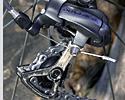 |
Shimano Dura-Ace 7900 offers a variety of notable improvements over 7800 such as the absolutely fantastic front shifting and superb brakes. Weight weenies will also herald the 112g decrease for the complete group.
However, Dura-Ace 7900 also carries with it a hefty price hike (about US$450), a polarizing two-tone finish, somewhat disappointing rear shift performance and some irritating quirks.
If you’re considering a new bike that comes equipped with Dura-Ace 7900, rest assured that you’d receive your ample share of performance and cachet in return. But if you’re currently 7800-equipped, the motivation for dropping the very substantial amount of cash on 7900 is indeed less compelling.
Prices and weights:
|
Price |
Weight |
Change from Dura-Ace 7800 |
ST-7900 |
US$700 |
366g |
-60g |
FC-7900 (172.5mm, 39/53T, w/BB) |
US$700, US$45 |
739g |
-11g |
RD-7900-SS |
US$300 |
164g |
-18g |
FD-7900-F |
US$150 |
66g |
-2g |
BR-7900 (w/o mounting hardware) |
US$440 |
285g |
-15g |
CS-7900 (12-25T) |
US$300 |
185g |
-7g |
CN-7900 |
US$70 |
282g |
+1g |
Total |
US$2705 |
2087g |
-112g |
Pros: Amazing front shift performance, fantastic brakes, concealed derailleur housings, exceptionally quiet drivetrain, über-smooth rear shifts, lighter than 7800, modern two-tone look, updated ergonomics
Cons: Can only downshift two gears per sweep, very long shift lever throws, very expensive, irritating cover plate on Dual Control levers, strange gap in lever when adjusted for shorter reach, exposed shifter guts, modern two-tone look, updated ergonomics
Cyclingnews rating: ![]()
Photography
For a thumbnail gallery of these images, click here
Images by James Huang/Cyclingnews.com
- Shimano's latest Dura-Ace group is a big step forwards in some ways - but not in others.
- The new STI Dual Control levers offer a drastically different shape from 7800.
- Last year's dip in the top of the lever has been replaced by a flatter and wider perch.
- The newly carbon brake lever is canted outwards a few degrees for an easier reach from the hoods.
- Shimano uses an annoying cover plate that must be removed in order to adjust reach or replace the brake cable.
- Shortening the reach leaves an unsightly gap - an oversight atypical of Shimano.
- Derailleur housing now runs beneath the handlebar tape and can be run either in front or in back of the bar.
- Running the derailleur housing in front leaves a sharp edge at the rear of the lever though.
- The shifter internals are dangerously exposed to the elements.
- The new Flight Deck computer is far easier to install now - just remove the top of the shifter and bolt on the new bits.
- The new crankset is undoubtedly one of the stars of the group and is now offered in a compact version as well.
- The deep-profile spider arms and incredibly expensive outer chainring yield absolutely superb front shifting performance.
- The heavily relieved spider keeps the weight down.
- Shimano retains last year's arm attachment method.
- The revised front derailleur cage is wider than before yet shifts superbly and also runs rub-free in the large chainring with no need for trim.
- Revised front derailleur pivot geometry requires more cable pull at the lever but yields a lighter feel that requires less effort.
- Rear shifts are as impeccably smooth and precise as before.
- The carbon fiber pulley cage is curiously flexy yet doesn't seem to affect shift performance.
- Braking is superb with the new calipers and revised cable pull ratio.
- Aggressive yet careful machining sheds weight while retaining stiffness. Low-profile barrel adjusters yield smoother routing for reduced friction.
- Shimano probably could have made the new calipers lighter but we wouldn't dare trade their superb stopping power and fingertip modulation to save a few grams.
- The asymmetrical chain is exceptionally quiet and shifts just as smoothly up front as out back in either direction.
- Cassettes have only been mildly revised and drop a few grams while seemingly losing none of their shift performance.
- Shimano has greatly expanded the range of available ratios to appeal to a wider audience.

